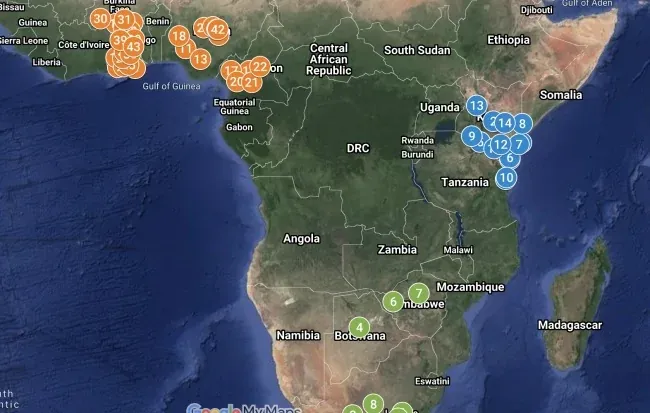The African Artifact Map at Boston University

The Boston University African Studies Center K-16 Education Program Artifact online map currently offers a catalogue of over 80 artifacts which are located at the Boston University African Studies Center. Artifacts are from several regions of Africa, including West Africa, Eastern/Central Africa, and Southern Africa. Students in elementary and middle school grades are able to navigate through this interactive resource by clicking on any artifact on the map and find images, as well as a list of resources about the artifacts’ origins, background, and history. Teachers in the Boston area can check out these physical resources for use in their classrooms.
In this challenging period defined by online learning, how can teachers open windows to the world in order to make global geographical and cultural content concrete for K-12 students? Teaching about Africa, a continent often omitted or erroneously represented in the elementary and secondary curriculum, can be especially difficult. One strategy is to introduce students to artifacts from various regions of Africa, which builds their ability to visualize local cultures.
The Boston University African Studies Center K-16 Education program is home to over 80 artifacts, which elementary and secondary teachers in the Boston area frequently check out to bring concrete objects into their classrooms. As part of our mission to increase awareness and knowledge of Africa by providing information, materials, and services to schools throughout the country, the K-16 Education program created the African Artifact Map to make these objects accessible to K-12 teachers nation-wide. The outreach manager and graduate students working at the African Studies Center researched key information to add to each artifact on the map. The Google Map interface provided a user-friendly and cost-effective means to make the artifacts available to a wider audience. The interactive map allows students and teachers to geographically locate artifacts on the map of Africa and click on each one to find out its provenance, context, and a list of resources about the background of the artifact.
The pedagogical value of such material culture extends beyond simply offering attention-grabbing visuals to students; it is an entry point for student inquiry and fosters a tangible understanding of daily life in various contexts. Artifacts generate curiosity, and curiosity calls for inquiry, a crucial entry point for engaged learning. Using curiosity-inducing visuals to foster learning can be as simple as a series of “I wonder how/why…” statements as a central principle of teaching social science. For example, the Mbuzi is a cooking tool used in Tanzania to grate the hard flesh of a coconut for local dishes. This tool provides students with an understanding of some common practices and items of Tanzanian cooking while highlighting the type of vegetation and climate found in this country.
Using concrete objects to support student learning about African cultures also replenishes students’ mental image banks which have been unfortunately filled with stereotypical and reductive ideas about Africa. Delving deeper into the ways these artifacts are used, experienced, and lived by real people helps rewire students’ cognitive schemas with rich and humanizing images. Artifacts such as the Oware mancala game in Ghana can invite young learners to see the commonalities of their daily lives with global cultures. Students can learn how to play the Oware mancala game by reconstructing it at home with dried beans and paper and playing it with their family members.

How to Use the African Artifact Map
The online map is freely accessible to K-12 teachers across the country. To find out more how teachers have used this tool, learn from the experience of Meg Smith, a teacher in Connecticut who uses the map in the context of her 5th grade Africa unit. For K-12 teachers located in the Boston area, all items can be checked out in person. For example, the Maimonides School in Brookline, MA checks out items every year to support their students’ learning about Kenya. Objects on the map are categorized into Western, Eastern, Northern, and Southern regions. A list of teacher resources is also provided for supplementary material on each object.
One way to approach these specific artifacts is to use them as entry points for understanding the larger context. For instance, the West Africa section offers a variety of musical instruments and includes gold weights that highlight the region’s rich Gold Coast history. This may be a way to teach about the medieval Trans-Saharan trade in West Africa. Teachers interested in Eastern and Central Africa may direct students toward the Clay Matatu Model. There, they will find that the artifact was made in Kenya by a 14-year-old boy. Its background context notes that its high technical quality and attention for colors and structure is impressive for someone of that age. Clicking on “For more information about the artifact” yields a list of resources ranging from articles about the current popular Matatu minibus culture in Nairobi, Kenya, to a video of a Kenyan artist’s endeavor of building matatu toy replicas. This also includes a teaching guide for third graders from a local teacher on making matatus in the classroom. Through this resource, teachers can start the conversation by asking students to observe the object and write down every physical attribute they notice. Students can then discuss their perceptions of transportation in Africa and how they are similar or different from the United States. Teachers who discuss South Africa may engage their students in analyzing the Anti-Apartheid Ribbon which was used in the 1980s by the African National Congress (ANC) to promote and strengthen the movement to end Apartheid.Teaching through material culture and highlighting its context of use plays a crucial role in generating curiosity, inquiry, and dismantling stereotypes. Challenging our students to think critically about culture provides them with a foundation for cultural competence and global understanding which helps them navigate through novel cultural situations and grow as global citizens.
The Boston University African Studies Center is a U.S. Department of Education Title VI National Resource Center and promotes the study of Africa through a rigorous academic program and enriching opportunities that engage scholars and professionals. The K-16 Education program has one overarching priority–to promote teaching about Africa in U.S. schools and in community colleges, Historically Black Colleges and Universities (HBCUs) as well as Minority Serving Institutions (MSIs). Through a variety of teaching resources, professional development events, a library of teaching resources, and a Teaching Africa Teacher Certificate, the program aims to encourage the incorporation of African Studies in every classroom.
During their time as Graduate Student Assistants at the Boston University African Studies Center, Hoda Yehia and Arianna Morrell both formatively helped research and implement the artifacts on the map. Arianna Morrell is a graduate student in the Master of Education (EdM) program in Educational Leadership & Policy Studies. Hoda Yehia is in the field of public health. Dr. Elsa Wiehe, educational researcher and K-6 teacher, is the outreach manager for the Boston University African Studies Center and she leads the center’s K-16 Education program.
The map project was developed under the leadership of Outreach Manager Breeanna Elliott, who is a Ph.D. Student in the History of Science and Medicine at Yale University.